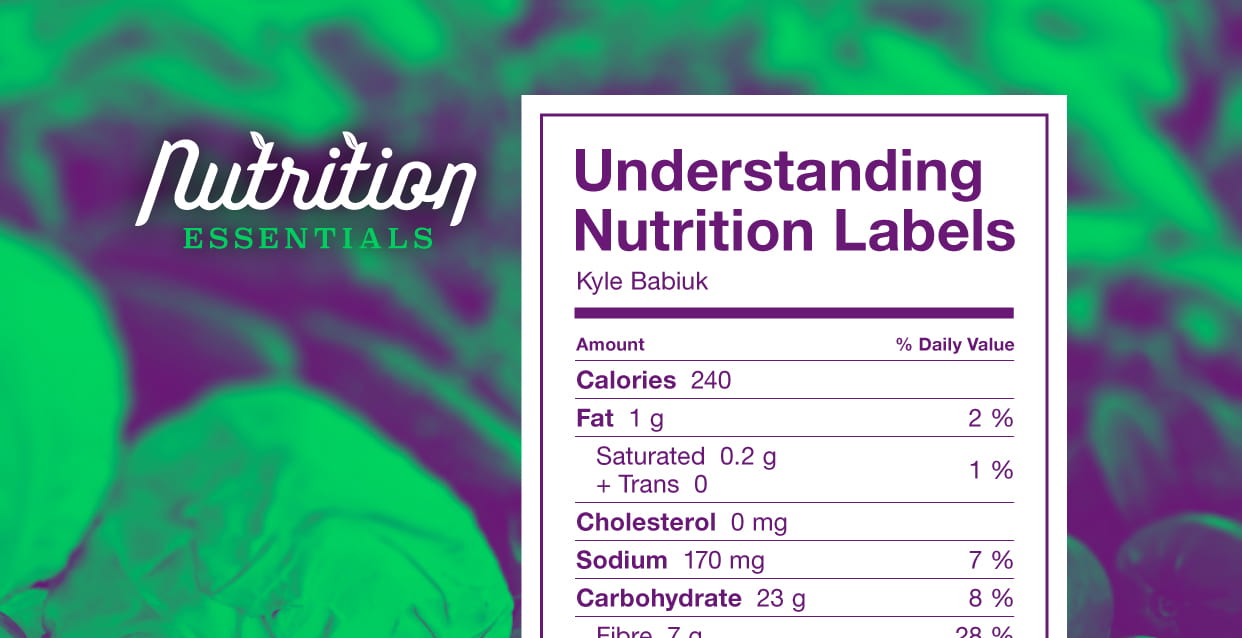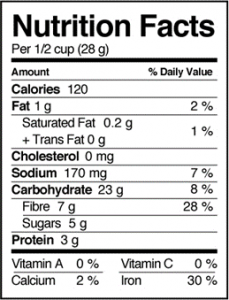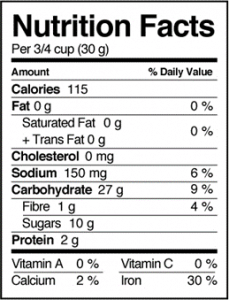Nutrition labels can be confusing and, in some cases, seem to be intentionally misleading, so let’s break them down to help clear up some of the confusion that starts at the top of the label. Making a note of the serving size is enormous. If you compare two labels, make sure you are comparing the same serving size of each. In the above example, the cereal on the right has a 25% greater volume than the left. Please note that even products that look similar and are from the same company will frequently adjust their serving sizes to ensure that caloric numbers are below certain thresholds. We can quickly multiply and estimate the amount of the interested nutrient better to compare the two, such as calories 115/.75 = 153.3 cal per cup vs. 120/0.5= 240 cal per cup. Lower or higher calories do not mean one is “better than the other,” but it should help you better to compare the two for your specific dietary needs.
% Daily Value
“% Daily Value” is an attempt by the government to give consumers a better understanding of the parts of their diet; however, I find this often leads to individuals getting confused and completely disregarding this value altogether. An important thing to note is the % Daily Value assumes a 2,000 calorie diet; why 2,000? Not sure, and it doesn’t matter for our purposes.
The % Daily Value can conflict with achieving a more balanced diet when used to aid in marketing specific products. If a product contains Less than 5% of something, it can be said to “have a little,” while if a product has greater than 15%, it can be said to “have a lot,” and since this is based on a 2,000 calorie diet these numbers can be significantly skewed. Sometimes serving sizes may be manipulated so that the retailer can make claims “High in Protein.” When we think back to the first article and remember that 1g of protein or carbohydrates = 4 Calories and 1g of fat = 9 Calories, we can see the relative protein, carb, and fat content of specific foods. Looking back at the two kinds of cereal, we can see 3g of protein in 120 Calories serving will be a relative protein % of (3*4)/120=10% of calories from protein, not bad but not great. The second cereal has 115 Calories and 2g of protein (2*4)/115=7% of calories from protein. If our diet were calling for an increase in protein, we would choose the first cereal as our breakfast. I think high protein foods contain at least 20% of their caloric load from protein. Using relative macro Calories rather than using the % Daily value allows for a greater understanding of a food’s specific makeup, allowing for a more customized approach to your diet.
Fiber
Fiber is a bit of a complex talking point as there is both soluble and insoluble fiber. For simplicity of this article, soluble fiber we can break down and digest, insoluble fiber we cannot. This summary is a bit of an oversimplification but works for our purposes. You will find the fiber content of foods located underneath the carbohydrates on the label, and it sometimes is broken down into insoluble and soluble fiber. Generally, avoid getting too complex with fiber; count it all as if it is a carbohydrate, and you should be fine. If you have digestive problems or other reasons why a dietician has stated you need a specific amount of fiber, listen to the professionals.
I have seen a new marketing tactic, especially amongst “health food products,” is the idea of “Net Carbs.” What companies are doing is saying that essentially insoluble fiber doesn’t get digested, so it does not count as Calories. As bacteria in our guts can release nutrients from insoluble fiber, our body can absorb these nutrients. Do not be fooled by the “net carb” marketing. Great sources of fiber are vegetables, many of which have been touted as “Superfoods” at one point or another, like broccoli, spinach, kale, cauliflower, swiss chard, and even raw raspberries. Try getting a significant amount of high fiber foods at least once a day every day to help keep you full, keep you regular, and maximize your vitamin and mineral intake.
GMO vs Organic
Since the GMO vs. organic debate is highly contentious, I only want to clarify some fundamental confusion so everyone can make an informed decision. The following descriptions of different genetic modifications should give you a better understanding of what is organic foods.
- Selective breeding: Two strains of plants are introduced and bred to produce offspring with specific features. Between 10,000 and 300,000 genes can be affected. This process is the oldest method of genetic modification and is typically not included in the GMO food category.
- Mutagenesis: Plant seeds are purposely exposed to chemicals or radiation to mutate the organisms. The offspring with the desired traits are kept and further bred. Mutagenesis is also not typically included in the GMO food category.
- RNA interference: Individual undesirable genes in plants are inactivated to remove any undesired traits—considered
- Transgenics: A gene is taken from one species and implanted in another to introduce a desirable trait—considered
As noted above, several different types of genetic manipulations can occur in plants, including selective breeding, which has been around since humans became an agricultural society. I also feel it necessary to point out that organic farming practices still use pesticides. One of the most common GMO crops, BT corn, generates the same chemical for defense against pests used by organic farmers, this does not mean organic farming is terrible, or GMO crops are dangerous. There is very little difference between them. Many studies have shown that the nutritional value of organic and GMO crops are similar if not identical.
There are hundreds if not thousands of different labels that corporations use. I just touched on a couple of the most common ones to get you to think about what is influencing your purchasing decisions. There are some perfect labels out there like “gluten-free” for celiacs, allergy alerts, and other health-related claims. Not all labels are bad but think to yourself, “does this label give me actionable information or not?”
Check out the first article in this series
Understanding Nutrition- Basics of Macronutrients and a Healthy Diet
Visit our website for information on training consultations, virtual coaching, plus individual and group personal training. If you’re ready to work with one of our Exercise Specialists, fill out the consultation form so we can connect you with the best trainer to help you meet your goals.
by Kyle Babiuk
Kyle is a Bachelor of Kinesiology Graduate and is certified with the Canadian Society for Exercise Physiologists. He specializes in movement analysis, chronic disease management through exercise and strength programming. He’s worked with athletes, individuals with chronic diseases, along with many other individuals trying to achieve their health and fitness goals.





